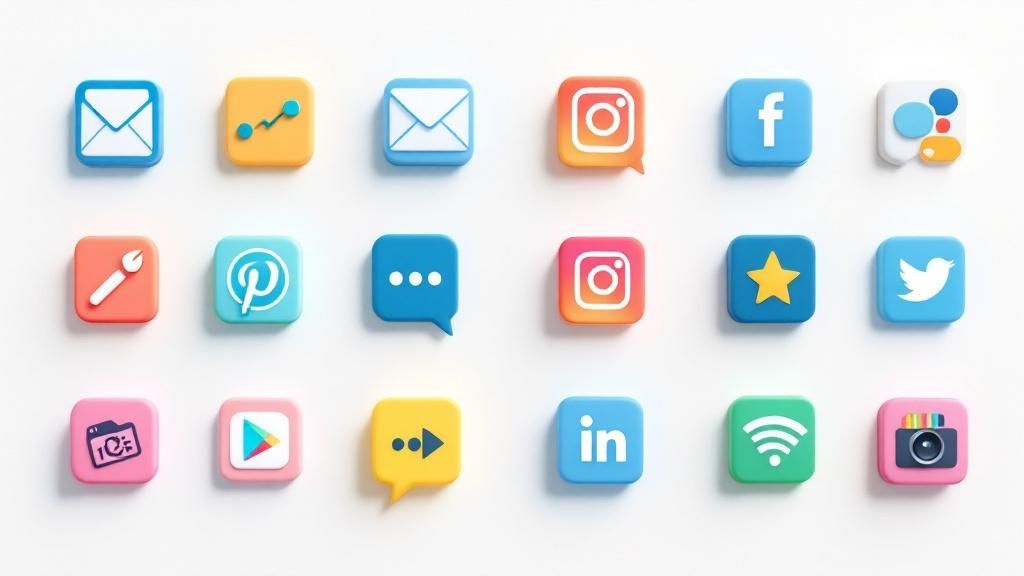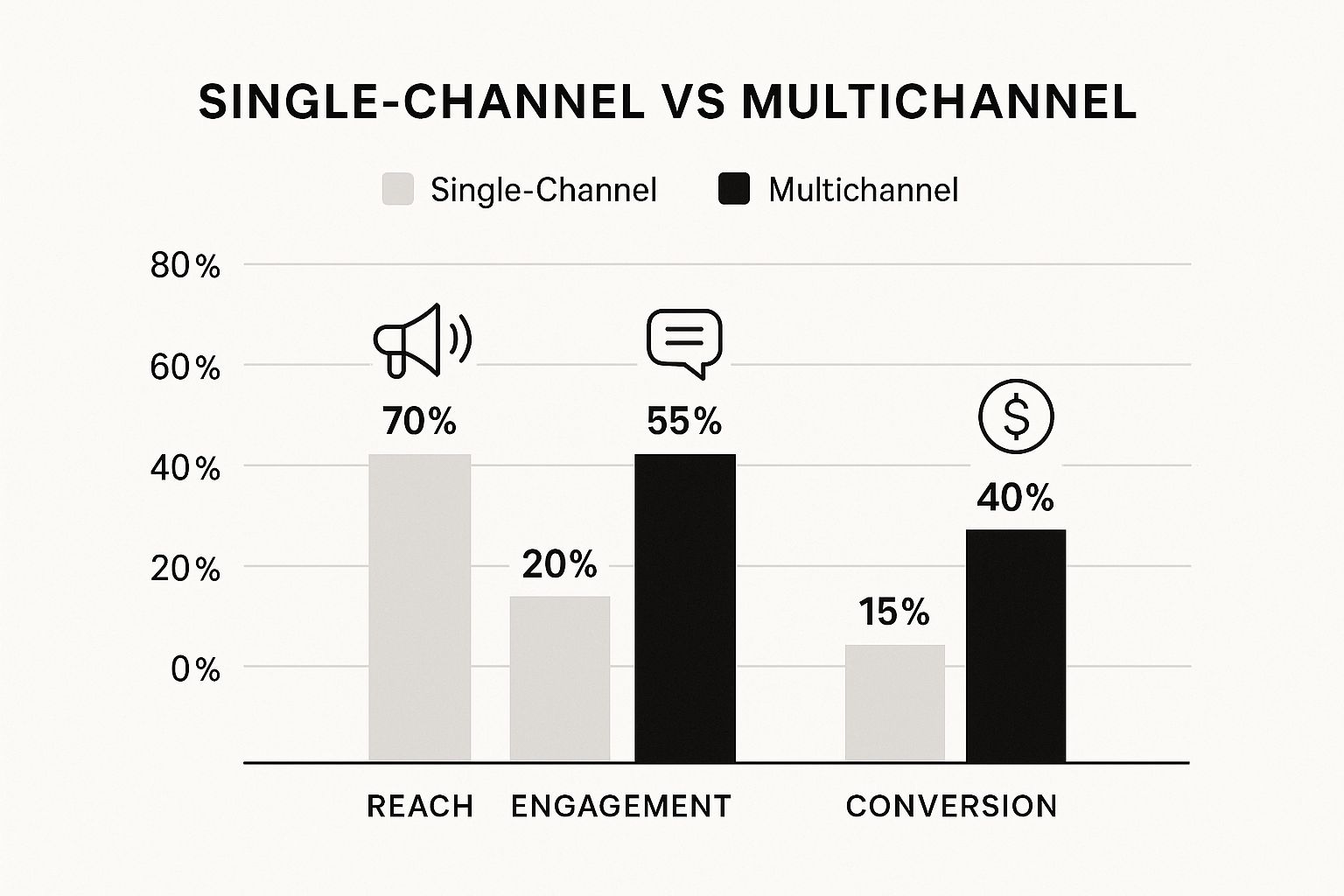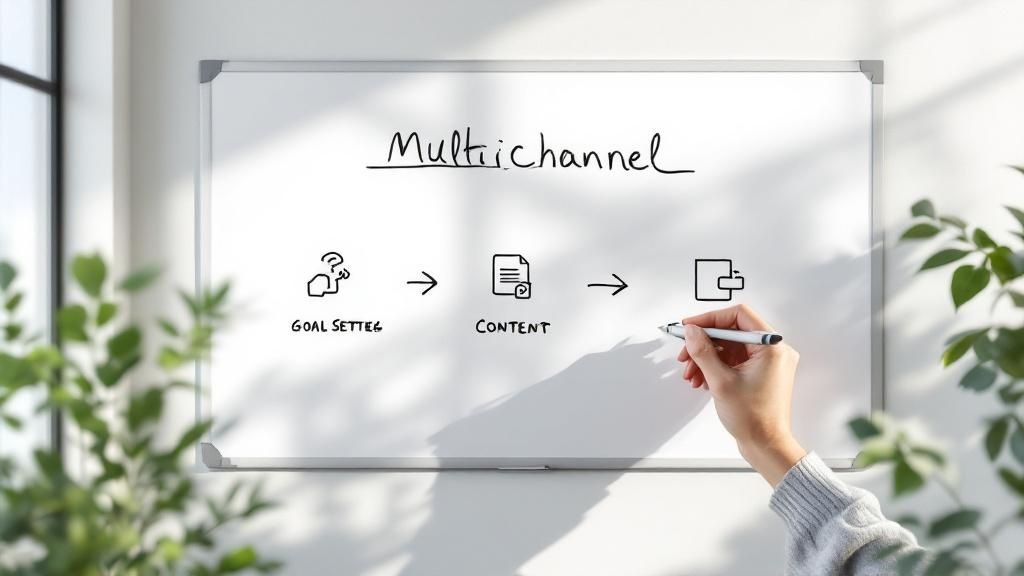Let's be honest, multichannel marketing sounds like another piece of industry jargon, but the idea behind it is actually pretty simple. At its core, it’s about using several different channels to connect with your customers.
Think of your favorite local coffee shop. You can probably walk in and order at the counter, use their mobile app to order ahead, or even get it delivered through a service like DoorDash. Each path gets you the same great coffee, but you get to choose the one that’s most convenient for you. That’s multichannel in a nutshell: giving people options to engage with your brand on the platforms they already use and love.
So, What Are These "Marketing Channels"?

The whole point of a multichannel strategy is to cast a wider net. Instead of putting all your eggs in one basket—say, just focusing on email—you meet your audience wherever they happen to be. That could be their email inbox, their LinkedIn feed, or a quick Google search. You're making it incredibly easy for people to find you and start a conversation.
This approach taps into a fundamental truth about people today: we don't all behave the same way. Some of us live in our email, while others would much rather discover a new brand through an Instagram story or a helpful blog post. By showing up on multiple channels, you make your brand more visible and, more importantly, more accessible.
A key thing to remember is that in a pure multichannel setup, the channels work independently. A customer's experience on your social media isn't necessarily linked to the email they received last week. The main goal here is offering choice, which is what separates multichannel from other, more integrated strategies.
Picking the Right Channels for Your Business
Jumping on every platform out there is a recipe for burnout. A smart strategy starts with knowing your audience inside and out, then picking the channels where they spend most of their time. This usually involves a mix of a few core areas:
- Social Media: Perfect for building a community and just getting your name out there (think LinkedIn, Instagram, or Facebook).
- Email Marketing: Still one of the best ways to nurture leads and have direct, one-on-one conversations.
- Content Marketing: Using things like blogs and articles to provide real value and draw people in organically.
- Paid Advertising: Great for hyper-targeted campaigns on search engines and social media to reach a specific audience quickly.
The real power of multichannel marketing comes from this emphasis on choice. To see just how different this is from a more traditional approach, let's break it down.
Multichannel vs Single-Channel Marketing at a Glance
This table gives a quick rundown of the core differences between relying on a single channel versus embracing a multichannel strategy.
| Attribute | Multichannel Marketing | Single-Channel Marketing |
|---|---|---|
| Brand Presence | Visible across multiple platforms where customers are active. | Limited to one platform, restricting reach. |
| Customer Choice | Customers can choose their preferred way to interact. | No choice; customers must use the single designated channel. |
| Data Insights | Gathers diverse data points from various customer behaviors. | Provides a very narrow, limited view of the customer. |
| Risk | Diversified; poor performance on one channel is offset by others. | High-risk; if the single channel fails, all marketing stops. |
As you can see, a multichannel approach not only broadens your reach but also provides a safety net. It respects your customers' preferences and gives you a much richer understanding of who they are and what they want.
Understanding The Core Multichannel Components
A winning multichannel strategy isn't just about showing up everywhere. It’s about having a deliberate game plan. Think of it like a championship sports team. You don’t just throw random players on the field; you have specialists—a quarterback, defenders, receivers—each with a distinct role, all working together to win.
Your marketing channels are your players. Email, social media, SMS, and live events each bring unique strengths to the game. The key is to coordinate their efforts toward a single goal: winning over customers. This coordination doesn't just happen; it’s built on a solid framework of three core components.

The Three Pillars Of A Strong Strategy
To build an approach that’s both coordinated and effective, your strategy needs to stand on three essential pillars. If you neglect any one of these, the whole thing can wobble and fall short.
-
Strategic Channel Selection: You have to pick the right channels—the ones where your audience actually spends their time. This isn’t about guesswork. It’s about using data to find the platforms that will deliver the most impact, whether that's LinkedIn for B2B professionals or Instagram for visually-driven consumer brands. Understanding the unique strengths of each channel, like effective Search Engine Optimization (SEO), is crucial.
-
Consistent Brand Messaging: Your brand’s voice, tone, and core message must be the same everywhere. A customer should get a familiar feeling whether they’re reading your blog, seeing a social media ad, or opening an email from you. That consistency is what builds trust and makes your brand memorable.
-
Integrated Data and Analytics: You need a way to track what’s working and what isn’t. By measuring performance on each channel, you can see which of your "players" are scoring points and which ones might need a new game plan. This data-driven approach lets you put your budget and effort where they’ll get the best possible return.
Multichannel vs. Omnichannel: What You Need to Know
This is an area where a lot of marketers get tripped up, but the distinction is actually pretty straightforward once you nail down the core difference.
Think of multichannel marketing like a city with several one-way streets all leading to the same downtown area—your brand. A customer can take any street they want to get there, whether it's social media, email, or an in-store visit. The catch is that these streets don’t connect to each other. Their journey on one street is completely separate from the others.
Omnichannel marketing, on the other hand, is more like a fully integrated highway system. Your customer can seamlessly change lanes and take different exits, and their GPS (your brand) knows their complete route the entire time. The experience is connected from the moment they start their journey.
The Key Difference Is Integration
While both strategies involve being present on multiple platforms, the real defining factor is integration.
Multichannel is all about giving customers choices on separate, independent platforms. An interaction a customer has on LinkedIn has no bearing on an email they receive from you later. Omnichannel, however, creates a single, unified customer journey where each channel is aware of the interactions happening on the others.
The infographic below really drives home just how much a multichannel presence can amplify your results compared to sticking with just one platform.

As you can see, the data makes a clear case: expanding to more channels dramatically boosts reach, engagement, and, most importantly, conversions.
To help clear up any lingering confusion, here’s a quick breakdown of the core differences between the two approaches.
Key Differences Between Multichannel and Omnichannel
| Feature | Multichannel Marketing | Omnichannel Marketing |
|---|---|---|
| Core Focus | Brand Presence | Customer Experience |
| Channel Interaction | Channels operate independently | Channels are integrated and work together |
| Customer Journey | Disjointed, separate experiences per channel | Seamless, continuous experience across all channels |
| Data Strategy | Siloed data for each channel | Centralized, unified customer data |
| Primary Goal | Maximize reach on as many channels as possible | Create a consistent and personalized journey for each customer |
Ultimately, a multichannel strategy prioritizes brand presence across various platforms, while an omnichannel strategy prioritizes a seamless customer experience across them. One isn't necessarily better than the other; the right choice really comes down to your business goals, resources, and technical capabilities.
For most B2B companies, building a strong multichannel approach is the most practical and powerful place to start. For example, you can learn more about why you should be using LinkedIn automation and see how it slots perfectly into a broader outreach plan that also includes email and other critical touchpoints.
How Winning Brands Use Multichannel Marketing

Theory is one thing, but seeing a strategy in action really makes it click. The brands that are truly winning get that different channels serve different purposes. They don’t just show up everywhere; they build their approach around this reality, treating each platform as a specific tool for a specific job.
Think about a modern retail company. Their multichannel playbook is a perfect example of this in motion:
- Email Marketing: This is their direct line for driving sales. They’ll send out weekly promo offers and flash sale alerts right to your inbox.
- Instagram & TikTok: Here, it’s all about community. They use behind-the-scenes content, share customer stories, and work with influencers to build brand love, not just push products.
- In-Store App: Their app houses a loyalty program that rewards repeat customers with points and exclusive deals, giving people a real reason to come back.
See how that works? Each channel plays its part, yet they all come together to meet customers wherever they happen to be.
A B2B Multichannel Example
This isn't just a B2C game. The same thinking is incredibly powerful in the B2B world, though the tools might look a bit different. A tech company selling new software, for instance, has its own set of channels for a very similar strategic goal.
Their process for high-value B2B lead generation might start with super-targeted LinkedIn ads to pinpoint professionals in the right industries and roles.
Once a lead bites, they're dropped into an automated email sequence that nurtures them with case studies and helpful content. The final step? A webinar that demonstrates the product’s value live, pulling prospects much closer to making a purchase.
In both the B2C and B2B worlds, the goal is never just to be on multiple platforms. The real magic is in understanding what makes each channel unique and using that strength to guide a prospect along their journey.
Winning brands also nail this approach for bigger campaigns. For example, they might build out a smart event marketing strategy that uses social media to create a buzz, email to handle registrations, and targeted follow-ups after the event to keep the conversation going.
The Business Case for a Multichannel Strategy
So, why go all-in on a multichannel approach? It's easy to dismiss it as just another trend, but the real value is in the hard, measurable results you see when you start meeting customers where they actually are.
The most immediate benefit is a massive boost in your reach. Instead of setting up shop on one channel and just hoping customers wander by, you're actively putting your brand right in front of them on the platforms they use every single day. That simple shift opens up doors to completely new audiences you would have otherwise missed.
Turning Browsers into Advocates
Beyond just getting more eyeballs on your brand, having multiple touchpoints is a game-changer for engagement. When customers can interact with you through email, social media, and your website, they start to feel a real connection.
Each of those interactions, no matter how small, is another chance to build trust. This is how you turn a casual browser into a loyal advocate for your brand. It’s a fundamental piece of building an effective multichannel sales strategy.
You don't have to take my word for it; the market trends tell the same story. The multichannel marketing market, currently valued at $9.25 billion, is expected to skyrocket to $11.67 billion. That's a clear signal of a huge industry-wide shift. You can dig into the research on multichannel market growth trends if you want to see the numbers for yourself.
Ultimately, each channel acts as a data goldmine. By gathering insights from different platforms, you get a much richer, more complete picture of customer behavior.
All this diverse data helps you understand which messages actually hit home, what products are flying off the shelves, and how different types of customers behave. It proves that offering people choices isn't just good customer service—it's just plain smart business.
Streamlining Your Outreach with Salesloop.io
Let's be honest. Juggling email campaigns, LinkedIn messaging, and other outreach efforts by hand is a quick path to burnout. This is where the theory of multichannel marketing crashes into the messy reality of actually doing it—and where the right tool can make a world of difference.
This exact complexity is what we built Salesloop.io to solve. Think of it as your central command center, letting you manage and automate your outreach across essential channels like email and LinkedIn, all from one dashboard. It’s designed to bring order to the chaos.
Unify and Automate Your Campaigns
The real challenge with multichannel isn't just being on different platforms; it's getting them to work together without you losing your mind. This is why the market for multichannel marketing hubs—platforms that pull all your campaign management into one place—is exploding.
That segment, valued at $5.8 billion, is projected to hit $6.44 billion. This isn't just a trend; it's a massive shift driven by the need for tools that offer both automation and clear, actionable insights. You can discover more insights about marketing technology trends to see the full picture for yourself.
Salesloop.io puts this power right at your fingertips. Instead of manually tracking who replied to what or setting calendar reminders for follow-ups, you can build entire sequences that just run on their own.
The dashboard below gives you a glimpse of what that centralized control looks like.
This is your mission control. You can see all active campaigns at once, tracking what's working without constantly switching between tabs and spreadsheets.
By integrating your campaign creation with performance analytics, you can finally stop guessing and start making data-backed decisions about what’s actually driving your growth.
Essentially, Salesloop.io takes a powerful, often complicated strategy and turns it into a simple, repeatable process. This makes effective multichannel outreach a real possibility for any business ready to scale its efforts.
Have Questions? We Have Answers.
Let's be honest, diving into multichannel marketing can feel like a lot at first. It's totally normal to have questions about how to get started and make it work without a massive team. Let's tackle some of the most common ones we hear.
What Is The First Step to Building a Multichannel Strategy?
The absolute first step, before you do anything else, is audience research. Seriously. Before you even think about which social media platform to post on or whether to run ads, you have to know where your ideal customers actually hang out online.
How do they like to be talked to? What platforms are they scrolling through? Don’t just guess. Use surveys, sift through customer feedback, and look at your website analytics to get real, hard data.
Once you have a clear picture of your audience, start small. Pick the two or three channels where they are most active. A laser-focused approach on the right platforms will always beat a scattered attempt to be everywhere at once.
How Do You Measure Multichannel Campaign Success?
This is a great question. You need to look at your results from two different altitudes: the close-up view of each channel and the 30,000-foot view of the whole campaign. It’s about seeing both the trees and the forest.
- Channel-Level Metrics: This is where you track the specific KPIs for each platform. Think email open rates, social media engagement (likes, comments, shares), or the click-through rates on your paid ads. These tell you how individual pieces are performing.
- Overall Campaign Metrics: Here, you zoom out to look at the big picture business goals. Are you actually generating more leads? What's your customer acquisition cost (CAC)? And what's the lifetime value (LTV) of the customers you're bringing in?
The goal is to connect the dots and see how each channel contributes to your main business objectives. That's how you know what's working and where to double down.
Can a Small Business Realistically Manage This Strategy?
Absolutely, and you don't need a huge budget or a sprawling marketing department to do it. The key for a small business is to be smart and strategic, not to boil the ocean.
Don't fall into the trap of thinking you need a presence on every single platform from day one. That's a surefire way to burn out.
Instead, find the two most impactful channels for your audience and pour your energy into mastering them. Using smart automation tools is also a complete game-changer here. They can help you manage your outreach efficiently without adding headcount. Remember, a perfectly executed two-channel strategy will run circles around a poorly managed five-channel mess every single time.
Ready to stop juggling tabs and manage your outreach from one central place? With Salesloop.io, you can automate your email and LinkedIn sequences, turning a complex strategy into a simple, powerful process. Start your journey with Salesloop.io today.





